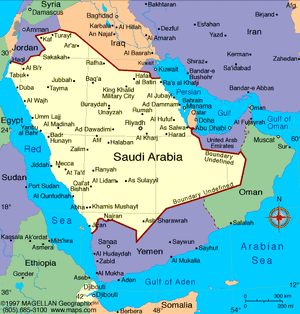Bab-el-Mandeb
| Author: Laxman Burdak, IFS (R). |


Bab-el-Mandeb is a strait between Yemen on the Arabian Peninsula, and Djibouti and Eritrea in the Horn of Africa. It connects the Red Sea to the Gulf of Aden.
Variants
- Arabic: باب المندب, lit. 'Gate of Lamentation',[1]
- Tigrinya: ባብ ኣል ማንዳብ
Jat Gotras Namesake
Name
The strait derives its name from the dangers attending its navigation or, according to an Arab legend, from the numbers who were drowned by an earthquake that separated the Arabian Peninsula from the Horn of Africa.[2]
In "Bab-el-Mandeb", "Bab" refers to "gate" while "Mandeb" refers to "lamentation".
Geography
The Bab-el-Mandeb acts as a strategic link between the Indian Ocean and the Mediterranean Sea via the Red Sea and the Suez Canal. The distance across is about 32 km from Ras Menheli in Yemen to Ras Siyyan in Djibouti. The island of Perim divides the strait into two channels, of which the eastern, known as the Bab Iskender (Alexander's Strait), is 3.2 km wide and 16 fathoms (96 ft; 29 m) deep, while the western, or Dact-el-Mayun, has a width of about 16 miles (26 km) and a depth of 170 fathoms (1,020 ft; 310 m). Near the coast of Djibouti lies a group of smaller islands known as the "Seven Brothers". There is a surface current inwards in the eastern channel, but a strong undercurrent outwards in the western channel.[3]
History
Paleo-environmental and tectonic events in the Miocene epoch created the Danakil Isthmus, a land bridge forming a broad connection between Yemen and Ethiopia.[4] During the last 100,000 years, eustatic sea level fluctuations have led to alternate opening and closing of the straits.[5]
According to the recent single origin hypothesis, the straits of Bab-el-Mandeb were probably witness to the earliest migrations of modern humans. It is presumed that the oceans were then much lower and the straits were much shallower or dry, which allowed a series of emigrations along the southern coast of Asia.
According to Ethiopian Orthodox Tewahedo Church tradition, the straits of Bab-el-Mandeb were witness to the earliest migrations of Semitic Ge'ez speakers into Africa, occurring c. 1900 BC, roughly around the same time as the Hebrew patriarch Jacob.[6] The Kingdom of Aksum was a major regional power in the Horn of Africa. It extended its rule across the strait with the conquest of the Himyarite Kingdom shortly before the rise of Islam.
Mention by Pliny
Pliny[7] mentions....We will now trace the rest of the coast that lies opposite to that of Arabia. Timosthenes has estimated the length of the whole gulf at four days' sail, and the breadth at two, making the Straits1 to be seven miles and a half in width.
1 The Straits of Bab-el-Mandeb.
बाब अल-मन्देब जलसन्धि
बाब अल-मन्देब अरबी प्रायद्वीप पर यमन और अफ़्रीका के सींग पर जिबूती, इरित्रिया और उत्तरी सोमालिया के बीच स्थित एक जलडमरू है जो लाल सागर को अदन की खाड़ी से जोड़ता है।
नाम की उत्पत्ति: अरबी भाषा में 'बाब अल-मन्देब' का मतलब 'दुख के द्वार' होता है। ध्यान दें कि यही 'मन्देब' शब्द हिन्दी में थोड़े परिवर्तित अर्थ के साथ 'मांदा' रूपों में देखा जाता है (मसलन 'थका-मांदा' में)। कहते हैं कि नाविकों के लिए इस जगह से गुज़ारना ख़तरनाक होता था और उनमें से बहुत यहाँ पानी के तेज बहाव में डूबकर जान खो बैठते थे। एक अन्य पारंपरिक कथा के अनुसार यहाँ बहुत पहले एक बड़ा भूकंप आया था जिस से एशिया और अफ़्रीका अलग हुए और इसमें बहुत से लोग मारे गए।
बाब अल-मन्देब हिन्द महासागर और भूमध्य सागर के बीच का एक बहुत ही महत्वपूर्ण समुद्री रास्ता है। सुएज़ नहर में जाने के लिए इस से भी निकलना ज़रूरी है। यमन के रास मनहेली से जिबूती के रास सियान तक इस जलडमरू की चौड़ाई लगभग 30 किमी है। इसमें पेरीम (بريم, Perim) नाम का एक द्वीप है जो इस जलडमरू को दो हिस्सों में बांटता है। पूर्वी भाग 'बाब इस्कंदर' (अर्थ: 'सिकंदर का द्वार') है जो सिर्फ़ 3 किमी चौड़ा और 30 मीटर गहरा है। पश्चिमी भाग 25 किमी चौड़ा और 310 मीटर गहरा 'दक़्त अल-मायून' (دقة المايون, Dact-el-Mayun) है। जिबूती के तट के पास टापुओं का एक गुट हैं जो 'सात भाई' (Seven Brothers) कहलाते हैं। पूर्वी जलडमरू में सतह पर एक लाल सागर के अन्दर की तरफ़ जाने वाला प्रवाह है जबकि पश्चिमी जलडमरू में सतह के नीचे लाल सागर से बाहर ले जाने वाला एक शक्तिशाली प्रवाह चलता है।
मानव इतिहास में महत्व: बहुत से इतिहासकारों का मनना है कि पूर्वी अफ़्रीका में उत्पन्न होने के बाद मानव जाति आज से लगभग 60000 वर्ष पूर्व बाब-अल-मन्देब लांघकर एशिया पहुंची थी। उस युग में समुद्रतल थोड़ा नीचे था और इन जलडमरुओं में या तो पानी कम था या यह सूखे ही थे। इस धारणा के अनुसार मानव यहीं से निकलकर सबसे पहले उस समय के मानव-रहित भारतीय उपमहाद्वीप में पहुंचे थे।
References
- ↑ Wehr's Arabic-English Dictionary, 196
- ↑ Baynes, T. S., ed. (1878), "Bab-el-Mandeb" , Encyclopædia Britannica, vol. 3 (9th ed.), New York: Charles Scribner's Sons, p. 179
- ↑ Baynes, T. S., ed. (1878), "Bab-el-Mandeb" , Encyclopædia Britannica, vol. 3 (9th ed.), New York: Charles Scribner's Sons, p. 179
- ↑ Henri J. Dumont (2009). The Nile: Origin, Environments, Limnology and Human Use. Monographiae Biologicae. Vol. 89. Springer Science & Business Media. p. 603. ISBN 9781402097263.
- ↑ Climate in Earth History. National Academies. 1982. p. 124. ISBN 9780309033299.
- ↑ Official website of EOTC
- ↑ Natural History by Pliny Book VI/Chapter 33
Back to Jat Places in Foreign

